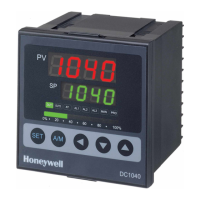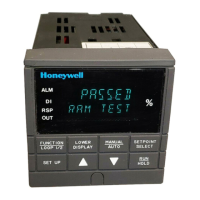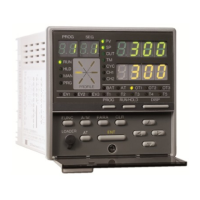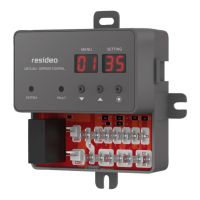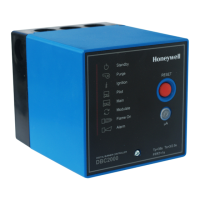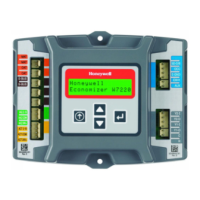2
1.2 Lock-out diagnoses
In case of a failure the LED is permanently illuminated. Every
10 seconds the illumination is interrupted by a flash code,
which indicates the cause of the error. Therefore the following
sequence is performed which is repeated as long as the unit
is not reset.
Sequence:
illuminated phase dark phase Flash-Code dark phase
❘ ❚ ❚ ❚ ❚
for 10 sec for 0.6 sec for 1.2 sec
Error diagnosis
Error message Flash-Code Possible fault
lockout ❘ ❚ ❚ ❚ ❚ within lock out safety time
no flame establishment
stray light ❘ ❘ ❚ ❚ ❚ stray light
during monitored phase,
detector may be faulty
Flash-Code for manual lock out
manual/external ❘ ❘ ❚ ❚ ❚ ❚ ❚ ❚ ❚ ❚
lock out
(see also 3. lock out and reset)
2. Flame detection
The following types of flame detectors are suitable:
– Ionisation probe, temperature resistant material, well
insulated (material and insulation same as for ignition
electrode).
– Infrared-flicker detector type IRD 1020.1 with mounting
flange M 93 or the UV solid state flame sensor UVD 971.
Flame detection using an ionisation probe is only possible
in conjunction with mains supplies which provides a neu-
tral earth connection.
Connecting the IRD 1020.1 or UVD 971 the correct wiring
has to be observed.
2.1 Stray light monitoring
The stray light check is performed at the end of the pre-
purge time for thr duration as mentioned in the table of
timings.
APPLICATION FEATURES
1. Information system
The information system is microprocessor based and re-
ports on all aspects of burner control box operation and
flame supervision. It informs continuously about the actual
programming sequence the unit is just performing. Besides
monitoring of the programming sequence it also allows to
identify errors during start-up of operation without any
additional testing devices. The automatically performed
diagnosis is a valuable tool which facilitates service/
maintenance work and therefore saves costs. The analyses
of the error cause can be done directly on stage or if not
possible afterwards as the lock out reason is stored in a non-
volatile lock out mode memory.
The information system communicates with the outside
world using a LED (the used Flash-Code is similar to the
Morse-Code). The messages are optically transmitted by a
appropriately flashing LED. Using an additional terminal
(optional), the messages can be recorded and displayed in
easy readable form.
1.1 Programming sequence display
The built-in microprocessor controls not only the pro-
gramming sequence but the information system too. The
individual phases of the programming sequence are
displayed as Flash-Code.
The following messages can be distinguished:
Message Flash-Code
waiting time ❘ ❘ ❘ .
tw
pre-ignition ❘ ❘ ❘ ❘ .
tvz
safety time ts ❚ ❘ .
post ignition tn
delay time to valve V2 ❚ ❘ ❘ .
tv2
running ❘ _
low mains voltage ❘ ❚ ❚ _
Internal fuse defect ❘ ❚ _
> control box defect
Description
❘ = short pulse
❚ = long pulse
. = short pause
_ = long pause
DKG 972
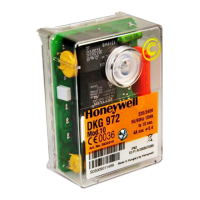
